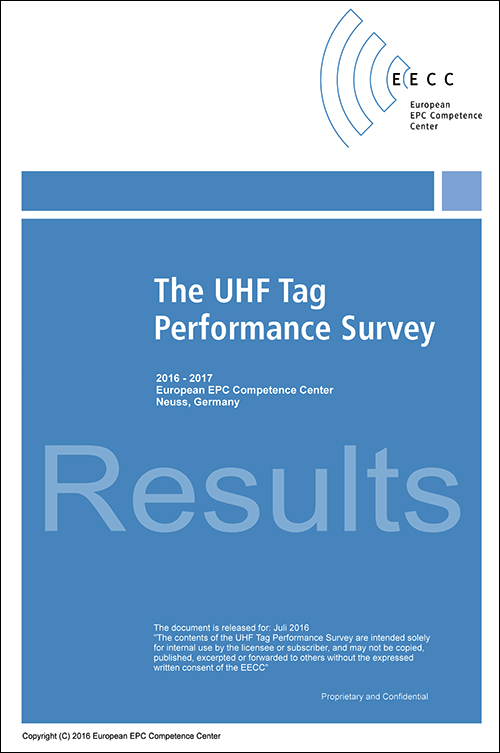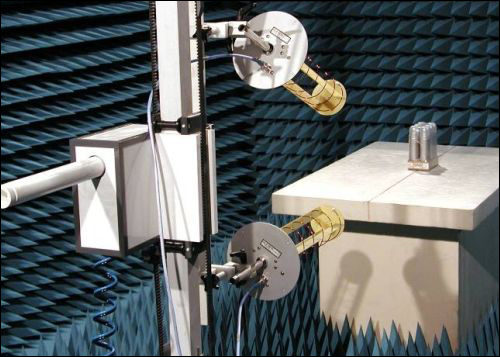Jul 13, 2016The European EPC Competence Center (EECC), a Germany-based provider of RFID services, released this week the newest edition of its annual UHF Tag Performance Survey (UTPS). In the 2016 edition, EECC researchers observe that on-metal tags are becoming smaller and increasing in sensitivity and reliability, and that new label manufacturers—many based in China—are offering affordable ultrahigh-frequency (UHF) RFID tags that meet the quality of other UHF tags already on the market. In addition, the group devotes a chapter to RFID moisture sensors tags, and indicates that such tags operate as effectively as standard UHF labels.
This is the 10th year in which the organization has conducted its tag-performance study to test UHF RFID transponders—both standard and on-metal labels—at its facility near Dusseldorf, Germany. Throughout the past decade, the EECC has increased the number of tags included in the testing process, while subjecting those tags to more types of tests.

The EECC tests all RFID tags across the entire RF spectrum, from 800 to 1,000 MHz, in accordance with the frequency bands used in different parts of the world. This year, the researchers tested 361 different models of passive UHF transponders in up to 22 different ways per tag. Of those transponders, 155 were on-metal tags, while one was a moisture sensor tag. This, says Christian von Uechtritz, the EECC's business-development manager for logistics, represents the largest number of tags ever tested by his organization. The testing identified various qualities, such as read range, backscatter range and write speed, as well as how read range was affected by the tag's orientation to an RFID reader.
The EECC made several changes to this year's testing procedures and survey results, von Uechtritz says. For one thing, the survey's appearance is changing to meet the needs of its audience. The survey had been growing more popular with end users (as opposed to technology providers) around the world; as a result, the latest survey is designed with end users, systems integrators and manufacturers in mind. "This report is a great tool for end users," von Uechtritz states, adding that it enables them to evaluate transponders' responses to specific types of testing that might match their own use cases.
"It's an easy way to find out which label is suitable for their business case," von Uechtritz says. "It's still a technical study, but we tried to create a graphical presentation." For instance, the report displays the power level required to activate each specific model of tag, as well as the power needed for that tag to respond, and also lists other tag models with similar results so that an end user can consider the available options.
For the 2016 survey, says Mauricio V. Leon, the EECC's technical manager, the organization opted to include moisture sensor tags in its benchmark tests. At this time, Leon explains, the category consists solely of a single transponder: SMARTRAC's Sensor DogBone inlay using RFMicron's S3 sensor chip. The testing found that it performed as well as many standard labels, while also transmitting data indicating the presence of moisture.
One of the newer performance measurements, which debuted in the 2015 survey, included a test for interference in a scenario in which two readers attempt to read the same tag simultaneously. The measurement simulated that scenario and evaluated the results to determine whether tags were jammed by the process—and, if so, which ones.
The EECC included tags from new and smaller companies, most based in Asia. The tag manufacturers submitted 50 of each make and model of tag for testing, from which the EECC then selected tags at random.
The study found that tags are becoming smaller for on-metal applications—as tiny as 7 millimeters by 2 millimeters by 2 millimeters (0.28 inch by 0.08 inch by 0.08 inch), in the case of a Xerafy tag. Of the metal tags tested, Leon reports, 23 were thin enough to be printed with regular printers. The sensitivity of on-metal tags, he notes, is improving at the same time that tag sizes are, in some cases, shrinking for on-metal applications.
In addition, the EECC found this year that chip diversity is increasing. Many of the chips now offer varying amounts of storage capacity, Leon says, and in some cases, they provide features previously unavailable that improve functionality. For instance, he says, Impinj's Monza R6 chip and RFMicron's Magnus S2 chip enable labels to adapt to the surface on which they are applied, adjusting to the presence of moisture on an item and functioning with the same sensitivity as they would have had that moisture not been present. "This means that the surface will not affect the performance," Leon states.
According to Leon, the EECC was pleased to see an improvement in tag functionality within tag-dense environments this year. For instance, he says, in the past, when tags were stacked together, those at the center of the stack did not always respond to the reader. This proximity effect, he adds, seems improved with the most recently released tags.
The researchers also tested for production consistency. They selected 30 labels from those supplied by the manufacturers at random, tested them to determine whether they all responded to interrogation at the same sensitivity and then measured that group's median performance. "For some on-metal tags, we found variations were very large," Leon says, describing last year's test results. This year, he notes, the on-metal tags showed less variation, though their performance was still not as consistent as that of the standard (not on-metal) RFID labels.
"This can be very important if you're choosing a transponder and looking for reliability," von Uechtritz says.
As the researchers prepare for the next survey—expected to be released in mid-2017—they are looking toward testing a greater number of RFID sensor tags. They also hope to potentially test tags with other capabilities that could be used for Internet of Things applications, either for the 2017 survey or for studies held in the future.
The EECC, formed in 2004 by GS1 Germany, Deutsche Post DHL and Metro Group, offers consulting services for UHF RFID technology development and deployment. During the past few years, says Niels Wientzek, the organization's senior software engineer, the group found a growing demand for software assistance as opposed to technical help with selection and use of tags and readers. For that reason, it offers custom software solutions based on customers' specific needs. The EECC is also providing assistance with EPCIS-based software solutions, he says, for end users and systems integrators.
With regard to the transponder surveys, the EECC invites all UHF RFID label manufacturers to submit their products for testing. There is no charge to the manufacturer, von Uechtritz notes, though some commercially available UHF RFID tags were nonetheless not tested this year, simply because the tags' manufacturers didn't provide them.
The new UTPS study is available in print for new customers for an annual subscription price of €495 ($598) for a five-year subscription, or €995 ($1,105) for a single copy.





